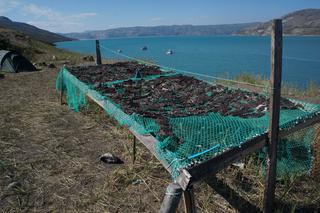Our official English website, www.x-mol.net, welcomes your
feedback! (Note: you will need to create a separate account there.)
Microbiota in foods from Inuit traditional hunting.
PLOS ONE ( IF 2.9 ) Pub Date : 2020-01-14 , DOI: 10.1371/journal.pone.0227819 Aviaja L Hauptmann 1, 2 , Petronela Paulová 3, 4 , Lars Hestbjerg Hansen 5 , Thomas Sicheritz-Pontén 6, 7 , Gert Mulvad 1 , Dennis S Nielsen 3
PLOS ONE ( IF 2.9 ) Pub Date : 2020-01-14 , DOI: 10.1371/journal.pone.0227819 Aviaja L Hauptmann 1, 2 , Petronela Paulová 3, 4 , Lars Hestbjerg Hansen 5 , Thomas Sicheritz-Pontén 6, 7 , Gert Mulvad 1 , Dennis S Nielsen 3
Affiliation

|
The foods we eat contain microorganisms that we ingest alongside the food. Industrialized food systems offer great advantages from a safety point of view, but have also been accused of depleting the diversity of the human microbiota with negative implications for human health. In contrast, artisanal traditional foods are potential sources of a diverse food microbiota. Traditional foods of the Greenlandic Inuit are comprised of animal-sourced foods prepared in the natural environment and are often consumed raw. These foods, some of which are on the verge of extinction, have not previously been microbiologically characterized. We mapped the microbiota of foods stemming from traditional Inuit land-based hunting activities. The foods included in the current study are dried muskox and caribou meat, caribou rumen and intestinal content as well as larval parasites from caribou hides, all traditional Inuit foods. This study shows that traditional drying methods are efficient for limiting microbial growth through desiccation. The results also show the rumen content of the caribou to be a highly diverse source of microbes with potential for degradation of plants. Finally, a number of parasites were shown to be included in the biodiversity of the assessed traditional foods. Taken together, the results map out a diverse source of ingested microbes and parasites that originate from the natural environment. These results have implications for understanding the nature-sourced traditional Inuit diet, which is in contrast to current day diet recommendations as well as modern industrialized food systems.
中文翻译:

因纽特人传统狩猎食品中的微生物群。
我们吃的食物含有与食物一同摄入的微生物。从安全的角度来看,工业化食品系统具有巨大的优势,但也被指控消耗人类微生物的多样性,对人类健康产生负面影响。相比之下,传统手工食品是多种食品微生物群落的潜在来源。格陵兰岛因纽特人的传统食品由在自然环境中制备的动物来源食品组成,并且经常以生食食用。这些食物,其中一些濒临灭绝,以前没有经过微生物学鉴定。我们绘制了源自因纽特人传统的陆上狩猎活动的食物的微生物群图。当前研究中包括的食物是干麝香和北美驯鹿肉,驯鹿瘤胃和肠内容物以及驯鹿皮的幼虫寄生虫,这是传统的因纽特人食品。这项研究表明,传统的干燥方法对于通过干燥限制微生物生长是有效的。结果还表明,驯鹿的瘤胃含量是高度多样化的微生物来源,具有植物降解的潜力。最后,已证明许多寄生虫被包括在评估的传统食品的生物多样性中。两者合计,结果绘制出了源自自然环境的多种摄入的微生物和寄生虫。这些结果对理解自然界传统的因纽特人饮食具有启示意义,这与当今的饮食建议以及现代工业化食品体系形成了鲜明的对比。所有传统的因纽特人食品。这项研究表明,传统的干燥方法对于通过干燥限制微生物生长是有效的。结果还表明,驯鹿的瘤胃含量是高度多样化的微生物来源,具有植物降解的潜力。最后,已证明许多寄生虫被包括在评估的传统食品的生物多样性中。两者合计,结果绘制出了源自自然环境的多种摄入的微生物和寄生虫。这些结果对理解自然界传统的因纽特人饮食具有启示意义,这与当今的饮食建议以及现代工业化食品体系形成了鲜明的对比。所有传统的因纽特人食品。这项研究表明,传统的干燥方法对于通过干燥限制微生物生长是有效的。结果还表明,驯鹿的瘤胃含量是高度多样化的微生物来源,具有植物降解的潜力。最后,已证明许多寄生虫被包括在评估的传统食品的生物多样性中。两者合计,结果绘制出了源自自然环境的多种摄入的微生物和寄生虫。这些结果对理解自然界传统的因纽特人饮食具有启示意义,这与当今的饮食建议以及现代工业化食品体系形成了鲜明的对比。结果还表明,驯鹿的瘤胃含量是高度多样化的微生物来源,具有降解植物的潜力。最后,已证明许多寄生虫被包括在评估的传统食品的生物多样性中。两者合计,结果绘制出了源自自然环境的多种摄入的微生物和寄生虫。这些结果对理解自然界传统的因纽特人饮食具有启示意义,这与当今的饮食建议以及现代工业化食品体系形成了鲜明对比。结果还表明,驯鹿的瘤胃含量是高度多样化的微生物来源,具有降解植物的潜力。最后,已证明许多寄生虫被包括在评估的传统食品的生物多样性中。两者合计,结果绘制出了源自自然环境的多种摄入的微生物和寄生虫。这些结果对理解自然界传统的因纽特人饮食具有启示意义,这与当今的饮食建议以及现代工业化食品体系形成了鲜明对比。结果显示出来自自然环境的多种摄入的微生物和寄生虫。这些结果对理解自然界传统的因纽特人饮食具有启示意义,这与当今的饮食建议以及现代工业化食品体系形成了鲜明对比。结果显示出来自自然环境的多种摄入的微生物和寄生虫。这些结果对理解自然界传统的因纽特人饮食具有启示意义,这与当今的饮食建议以及现代工业化食品体系形成了鲜明对比。
更新日期:2020-01-15
中文翻译:

因纽特人传统狩猎食品中的微生物群。
我们吃的食物含有与食物一同摄入的微生物。从安全的角度来看,工业化食品系统具有巨大的优势,但也被指控消耗人类微生物的多样性,对人类健康产生负面影响。相比之下,传统手工食品是多种食品微生物群落的潜在来源。格陵兰岛因纽特人的传统食品由在自然环境中制备的动物来源食品组成,并且经常以生食食用。这些食物,其中一些濒临灭绝,以前没有经过微生物学鉴定。我们绘制了源自因纽特人传统的陆上狩猎活动的食物的微生物群图。当前研究中包括的食物是干麝香和北美驯鹿肉,驯鹿瘤胃和肠内容物以及驯鹿皮的幼虫寄生虫,这是传统的因纽特人食品。这项研究表明,传统的干燥方法对于通过干燥限制微生物生长是有效的。结果还表明,驯鹿的瘤胃含量是高度多样化的微生物来源,具有植物降解的潜力。最后,已证明许多寄生虫被包括在评估的传统食品的生物多样性中。两者合计,结果绘制出了源自自然环境的多种摄入的微生物和寄生虫。这些结果对理解自然界传统的因纽特人饮食具有启示意义,这与当今的饮食建议以及现代工业化食品体系形成了鲜明的对比。所有传统的因纽特人食品。这项研究表明,传统的干燥方法对于通过干燥限制微生物生长是有效的。结果还表明,驯鹿的瘤胃含量是高度多样化的微生物来源,具有植物降解的潜力。最后,已证明许多寄生虫被包括在评估的传统食品的生物多样性中。两者合计,结果绘制出了源自自然环境的多种摄入的微生物和寄生虫。这些结果对理解自然界传统的因纽特人饮食具有启示意义,这与当今的饮食建议以及现代工业化食品体系形成了鲜明的对比。所有传统的因纽特人食品。这项研究表明,传统的干燥方法对于通过干燥限制微生物生长是有效的。结果还表明,驯鹿的瘤胃含量是高度多样化的微生物来源,具有植物降解的潜力。最后,已证明许多寄生虫被包括在评估的传统食品的生物多样性中。两者合计,结果绘制出了源自自然环境的多种摄入的微生物和寄生虫。这些结果对理解自然界传统的因纽特人饮食具有启示意义,这与当今的饮食建议以及现代工业化食品体系形成了鲜明的对比。结果还表明,驯鹿的瘤胃含量是高度多样化的微生物来源,具有降解植物的潜力。最后,已证明许多寄生虫被包括在评估的传统食品的生物多样性中。两者合计,结果绘制出了源自自然环境的多种摄入的微生物和寄生虫。这些结果对理解自然界传统的因纽特人饮食具有启示意义,这与当今的饮食建议以及现代工业化食品体系形成了鲜明对比。结果还表明,驯鹿的瘤胃含量是高度多样化的微生物来源,具有降解植物的潜力。最后,已证明许多寄生虫被包括在评估的传统食品的生物多样性中。两者合计,结果绘制出了源自自然环境的多种摄入的微生物和寄生虫。这些结果对理解自然界传统的因纽特人饮食具有启示意义,这与当今的饮食建议以及现代工业化食品体系形成了鲜明对比。结果显示出来自自然环境的多种摄入的微生物和寄生虫。这些结果对理解自然界传统的因纽特人饮食具有启示意义,这与当今的饮食建议以及现代工业化食品体系形成了鲜明对比。结果显示出来自自然环境的多种摄入的微生物和寄生虫。这些结果对理解自然界传统的因纽特人饮食具有启示意义,这与当今的饮食建议以及现代工业化食品体系形成了鲜明对比。











































 京公网安备 11010802027423号
京公网安备 11010802027423号